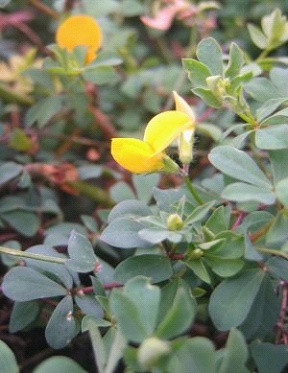Lotus corniculatus var. Japonicus
| Lotus corniculatus var. Japonicus | ||||||||||||
|---|---|---|---|---|---|---|---|---|---|---|---|---|

Lotus corniculatus var. Japonicus 'Gifu' |
||||||||||||
| Systematics | ||||||||||||
|
||||||||||||
| Scientific name | ||||||||||||
| Lotus corniculatus var. Japonicus | ||||||||||||
| rule |
Lotus corniculatus var. Japonicus ( Syn. Lotus japonicus ) is a variety of common horn clover ( Lotus corniculatus ). It belongs to the genus Hornklee ( Lotus ) in the subfamily of the butterflies (Faboideae) within the family of the legumes (Fabaceae).
description
Lotus corniculatus var. Japonicus is an upright or crawling growing, perennial , herbaceous plant . It is hairless or slightly hairy on the stems, petioles and leaf veins. The leaves are five-pinnate, with two of the leaflets sitting on the stem base. The umbrella-shaped inflorescence contains one to three, rarely four individual flowers. The petals are yellow. The seed pods, which are 2 cm to 2.5 cm long, change color from green to yellow to dark brown during the ripening process. The oval seeds measure 1 to 1.7 mm in diameter.
The number of chromosomes is 2n = 12.
Occurrence
The distribution area of Lotus corniculatus var. Japonicus is in East and Central Asia and extends from Japan, Korea and China via Nepal to Kashmir. Altitudes up to 3100 meters are populated.
Lotus corniculatus var. Japonicus as a model organism in biology
Lotus corniculatus var. Japonicus was chosen as a model plant for legume research in the 1990s . Compared to other, agriculturally relevant legumes, Lotus corniculatus var. Japonicus has a relatively small genome with around 450 Mbp and 6 chromosomes in the haploid set . This makes Lotus corniculatus var. Japonicus significantly more accessible for molecular biology techniques for the isolation and characterization of genes . Further advantages are that Lotus corniculatus var. Japonicus is autocompatible and self-pollinating, comes from sowing to flower in a short time, and produces a large number of seeds. Standardized techniques for tissue culture and manipulation of DNA using Agrobacterium tumefaciens as a vector have been described.
Lotus corniculatus var. Japonicus is next to Medicago truncatula of particular interest as a model plant, as it is capable of both root nodule symbiosis with rhizobia and mycorrhiza with fungi of the phylum Glomeromycota . Research on both model legumes will make a decisive contribution to understanding the fundamental processes that lead to the formation of the root nodules and mycorrhiza. In recent years, numerous genes have been identified and isolated which are essential for the development of both or one of the symbioses. The genome is to be completely sequenced.
Systematics
The first description of Lotus corniculatus var. Japonicus was published in 1864 by Eduard August von Regel in a list of plants in the St. Petersburg Botanical Garden. An alternative classification in the rank of a species , not a variety, was described by Kai Larsen in 1955.
Individual evidence
- ↑ a b Entry on Lotus corniculatus var. Japonicus in the Germplasm Resources Information Network
- ↑ a b c Lotus corniculatus . In: Deyuan Hong, Wu Zhengyi, Peter H. Raven (eds.): Flora of China . tape 10 : Fabaceae . Missouri Botanical Garden Press, St. Louis 2010, ISBN 978-1-930723-91-7 , pp. 318 ( eFloras.org ).
- ↑ a b J. Stougaard: Lotus japonicus . In: Sydney Brenner, Jeffrey H. Miller (Eds.): Encyclopedia of Genetics . 2001, ISBN 978-0-12-227080-2 , pp. 1121–1122 , doi : 10.1006 / rwgn.2001.1665 .